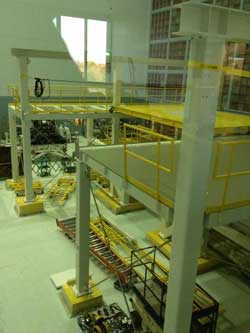Assembly stand completed for NASA's Webb Telescope flight optics

This is the Webb Telescope Ambient Optical Assembly Stand. Credit: NASA/Maggie Masetti<br>
“This milestone is important as it marks the transition to the integration and testing phase for the Webb telescope's optical telescope element,” said Lee Feinberg, Optical Telescope Element Manager for the Webb telescope at Goddard.
The Webb telescope is the world's next-generation space observatory and scientific successor to the Hubble Space Telescope. The most powerful space telescope ever built, Webb will observe the most distant objects in the universe, provide images of the very first galaxies ever formed and study planets around distant stars.
The installation of the giant structural steel optical assembly stand was recently completed at Goddard by Northrop Grumman in Redondo Beach, Calif. and its teammate ITT Exelis, McLean, Va. Northrop Grumman is leading the design and development effort for the telescope under contract to Goddard.
“Due to the excellent efforts of our teammate ITT Exelis, we have completed each of the major elements of equipment required to complete the assembly of the optical flight telescope,” said Scott Willoughby, Webb telescope vice president and program manager at Northrop Grumman Aerospace Systems. “With the near completion of the final cryotest for the last six flight mirror segments, we are making great progress on the program.”
The U-shaped optical assembly stand is is 24 feet high, 52 feet wide and 41 feet long and weighs 139,000 pounds. Its purpose is to cradle the entire 3.7 metric ton optical telescope and install 18 individual 90 pound mirror segments and other components onto the telescope structure with better than one one-thousandth of an inch precision. The platform has been installed in Goddard's largest clean room where Northrop Grumman and ITT will assemble the telescope in late 2014.
ITT Exelis teammate JPW Companies in Syracuse, N.Y. built the massive structure. Two other ITT teammates supplied other elements of the assembly stand: Cranetech, Inc. designed and built the track system suspended above the stand and Progressive Machine and Design made the robotic arms attached to the track that install the mirror segments. The ITT Exelis team spent a year incrementally building and demonstrating the mirror installation equipment.
“The integration equipment is a critical piece of the Webb telescope program. Over the past three years, ITT Exelis has developed a risk reduction program to demonstrate the key elements of this equipment,” said Rob Mitrevski, vice president and general manager, Intelligence, Surveillance and Reconnaissance Systems at ITT Exelis Geospatial Systems. “With the delivery of the assembly stand, all of the equipment is coming together in preparation for the telescope assembly effort.”
The Webb telescope is a joint project of NASA, the European Space Agency and the Canadian Space Agency.
For more information about the James Webb Space Telescope, visit:
http://jwst.nasa.gov
To see the assembly stand and other Webb telescope components in Goddard's cleanroom, visit:
http://www.jwst.nasa.gov/webcam.html
Media Contact
More Information:
http://www.nasa.govAll latest news from the category: Physics and Astronomy
This area deals with the fundamental laws and building blocks of nature and how they interact, the properties and the behavior of matter, and research into space and time and their structures.
innovations-report provides in-depth reports and articles on subjects such as astrophysics, laser technologies, nuclear, quantum, particle and solid-state physics, nanotechnologies, planetary research and findings (Mars, Venus) and developments related to the Hubble Telescope.
Newest articles

Properties of new materials for microchips
… can now be measured well. Reseachers of Delft University of Technology demonstrated measuring performance properties of ultrathin silicon membranes. Making ever smaller and more powerful chips requires new ultrathin…

Floating solar’s potential
… to support sustainable development by addressing climate, water, and energy goals holistically. A new study published this week in Nature Energy raises the potential for floating solar photovoltaics (FPV)…

Skyrmions move at record speeds
… a step towards the computing of the future. An international research team led by scientists from the CNRS1 has discovered that the magnetic nanobubbles2 known as skyrmions can be…





















